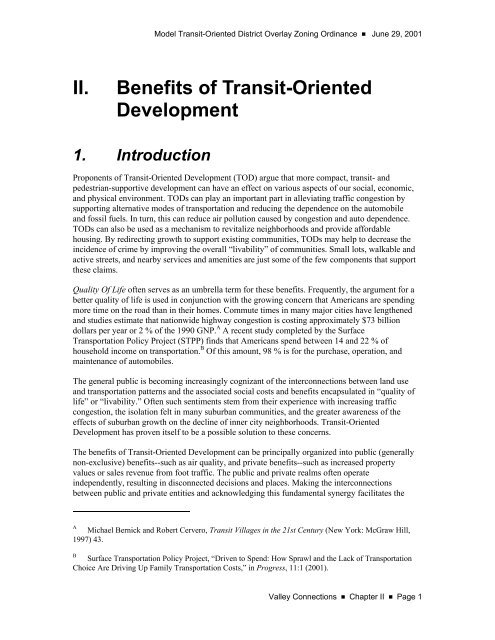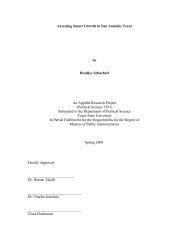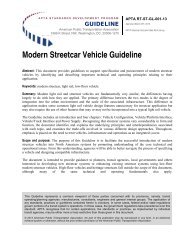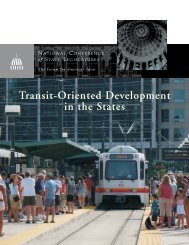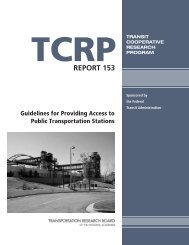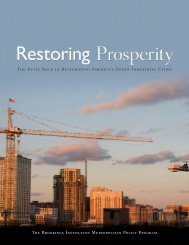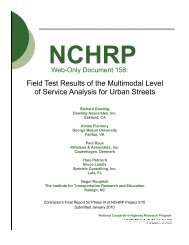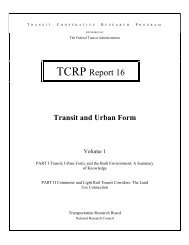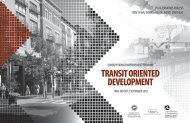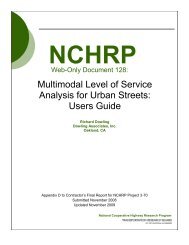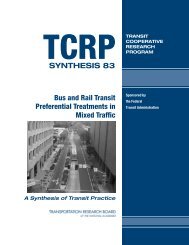Model TOD Zoning Ordinance (PDF, 3.7 MB) - Reconnecting America
Model TOD Zoning Ordinance (PDF, 3.7 MB) - Reconnecting America
Model TOD Zoning Ordinance (PDF, 3.7 MB) - Reconnecting America
You also want an ePaper? Increase the reach of your titles
YUMPU automatically turns print PDFs into web optimized ePapers that Google loves.
<strong>Model</strong> Transit-Oriented District Overlay <strong>Zoning</strong> <strong>Ordinance</strong> ■ June 29, 2001II.Benefits of Transit-OrientedDevelopment1. IntroductionProponents of Transit-Oriented Development (<strong>TOD</strong>) argue that more compact, transit- andpedestrian-supportive development can have an effect on various aspects of our social, economic,and physical environment. <strong>TOD</strong>s can play an important part in alleviating traffic congestion bysupporting alternative modes of transportation and reducing the dependence on the automobileand fossil fuels. In turn, this can reduce air pollution caused by congestion and auto dependence.<strong>TOD</strong>s can also be used as a mechanism to revitalize neighborhoods and provide affordablehousing. By redirecting growth to support existing communities, <strong>TOD</strong>s may help to decrease theincidence of crime by improving the overall “livability” of communities. Small lots, walkable andactive streets, and nearby services and amenities are just some of the few components that supportthese claims.Quality Of Life often serves as an umbrella term for these benefits. Frequently, the argument for abetter quality of life is used in conjunction with the growing concern that <strong>America</strong>ns are spendingmore time on the road than in their homes. Commute times in many major cities have lengthenedand studies estimate that nationwide highway congestion is costing approximately $73 billiondollars per year or 2 % of the 1990 GNP. A A recent study completed by the SurfaceTransportation Policy Project (STPP) finds that <strong>America</strong>ns spend between 14 and 22 % ofhousehold income on transportation. B Of this amount, 98 % is for the purchase, operation, andmaintenance of automobiles.The general public is becoming increasingly cognizant of the interconnections between land useand transportation patterns and the associated social costs and benefits encapsulated in “quality oflife” or “livability.” Often such sentiments stem from their experience with increasing trafficcongestion, the isolation felt in many suburban communities, and the greater awareness of theeffects of suburban growth on the decline of inner city neighborhoods. Transit-OrientedDevelopment has proven itself to be a possible solution to these concerns.The benefits of Transit-Oriented Development can be principally organized into public (generallynon-exclusive) benefits--such as air quality, and private benefits--such as increased propertyvalues or sales revenue from foot traffic. The public and private realms often operateindependently, resulting in disconnected decisions and places. Making the interconnectionsbetween public and private entities and acknowledging this fundamental synergy facilitates theAMichael Bernick and Robert Cervero, Transit Villages in the 21st Century (New York: McGraw Hill,1997) 43.BSurface Transportation Policy Project, “Driven to Spend: How Sprawl and the Lack of TransportationChoice Are Driving Up Family Transportation Costs,” in Progress, 11:1 (2001).Valley Connections ■ Chapter II ■ Page 1


